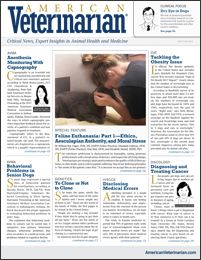IVECCS 2017: Disclosing Medical Errors
Veterinarians need to be comfortable speaking out about errors to clients, team members, and themselves.

Admitting mistakes is a tough pill for just about anyone to swallow. It leaves you feeling vulnerable, defenseless, and unpro- tected from the reaction of the person you faulted. Nevertheless, we all want to be informed of errors, especially when it comes to health care.
One study in human medicine reported that 98% of patients want some type of acknowledgment when even minor medical errors are made.1 But only 30% of physicians share medical errors openly with their patients.1
At the 2017 International Veterinary Emergency and Critical Care Symposium in Nashville, Linda Fineman, DVM, DACVIM (Oncology), explained that although fewer studies have been published regarding medical errors in veterinary medicine, there are many reasons to believe the statistics are similar.
“Many of us have been trained in a culture where we are expected to be infallible and to make an error is a source of shame, despite the growing awareness that expecting error-free practice is unrealistic,” said Dr. Fineman, who is the director of veterinary talent and knowledge strategy at Ethos Veterinary Health in Woburn, Massachusetts.
What action is considered a medical error? It’s based on the idea that another veterinary professional would have recognized the care decisions and actions a person made to be in error at the time they were being made. “If a veterinarian does something that either does or does not cause harm but it’s not within the standard of care within that community, that’s an error,” Dr. Fineman said. “I want to emphasize that not all errors do cause harm.”
By being open with clients about medical errors, you and your veterinary practice will benefit in numerous ways. Disclosing medical errors in the proper manner allows you and your practice to:
- Stay consistent with the code of ethics of veterinary medicine
- Rebuild trust with clients and veterinary team members
- Retain clients and your practice’s reputation
- Reach fair settlements if the client decides to sue
- Reduce the risk of board complaints and lawsuits
Despite knowing that clients want to understand what happened, veterinarians still find it difficult to disclose errors. There’s a huge mismatch between this knowledge and what usually ends up happening after an error occurs, Dr. Fineman said.
Applying the Team Model
Veterinarians often respond by mentioning the adverse event but not the fact that the event happened as a result of an error. Instead of shying away from disclosing medical errors, veterinarians should educate themselves on the TEAM module for disclosure, which involves Truth, Empathy, Apologizing, and Managing the situation.
Be Truthful
Acknowledge that an error occurred. Be upfront and open and don’t put up any walls between yourself and the client. “As you’re telling the truth, share the basics and then stop and ask the client how he or she is feeling,” Dr. Fineman suggested.
Empathize
Address the client’s thoughts, feelings, and needs. Show that you understand how difficult this situation must be for the client. “I think empathy is absolutely critical,” Dr. Fineman said. “By using empathy and reflective listening, what we’re showing that client is that we hear, acknowledge, and understand the issues they’re having, and that it’s OK for them to have emotions and negativity about the bad experience they had.”
Apologize
Give the client an apology of responsibility—“I’m sorry I made this error”—not an apology of sympathy—“I’m sorry this happened to you.” Apologies need to include an explanation of what happened, said Dr. Fineman, “and also a fair offer for how you will make it right.”
Manage Through to Resolution
Fair reparations, whether financial or otherwise, need to be made. Ask the client what more you can do for him or her. If the client would rather have the pet transferred to another hospital or practice, be comfortable in setting that up. “Be accountable and make arrangements for reparations,” Dr. Fineman said. “For example, waive the fees that are appropriate to waive. If the patient is hospitalized for 3 days because you gave him pneumonia, the client better not be paying for that.”
Before Disclosure
Prior to having the difficult disclosure conversation, make sure that 4 things are accomplished: (1) take care of the patient’s immediate needs, (2) take care of yourself and your staff, (3) develop clarity about what happened, and (4) think about what you are going to say to the client.
Self-awareness of your emotional state is ultimately the key to getting through this difficult conversation. After becoming aware that a medical error occurred, you will most likely be overwhelmed with myriad emotions. Take some time to manage your own reactions before you try to help your client manage his or her reaction.
“The idea that if you make a mistake you are to blame and should feel ashamed—that’s not healthy,” Dr. Fineman said. “We have to speak about errors. We have to own them and admit to them out loud. We have to say, ‘I made this mistake, and here’s what happened.’ Gather your team around you and say, ‘Let’s work together to figure out how we can build in double checks.’”
The Bottom Line
Not disclosing medical errors to your clients will cause more harm than good for you and your practice in the long run. According to that same human study, nondisclosure leads to feelings of anger (90%), bitterness (80%), betrayal (55%), and humiliation (40%) in patients.1
Errors and mistakes are a part of life, and it is our professional responsibility to be open with our clients, our staff, and ourselves about them.
Reference:
- Witman AB, Park DM, Hardon SB. How do patients want physicians to handle mistakes? A survey of internal medicine patients in an academic setting. JAMA. 1996;156(22):2565-2569.
